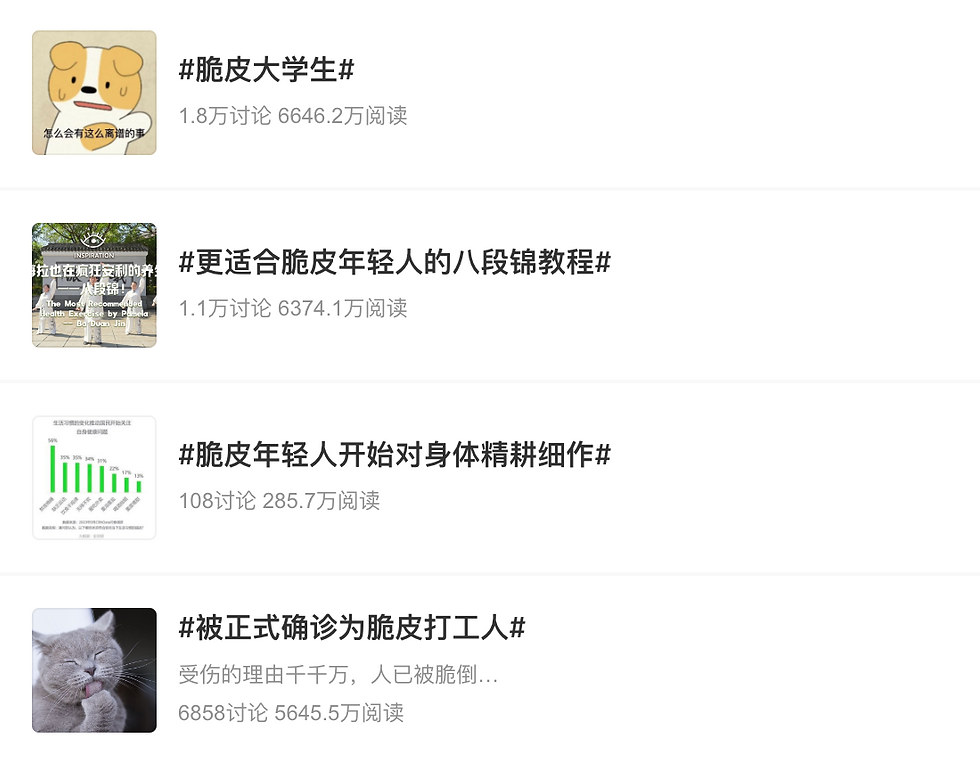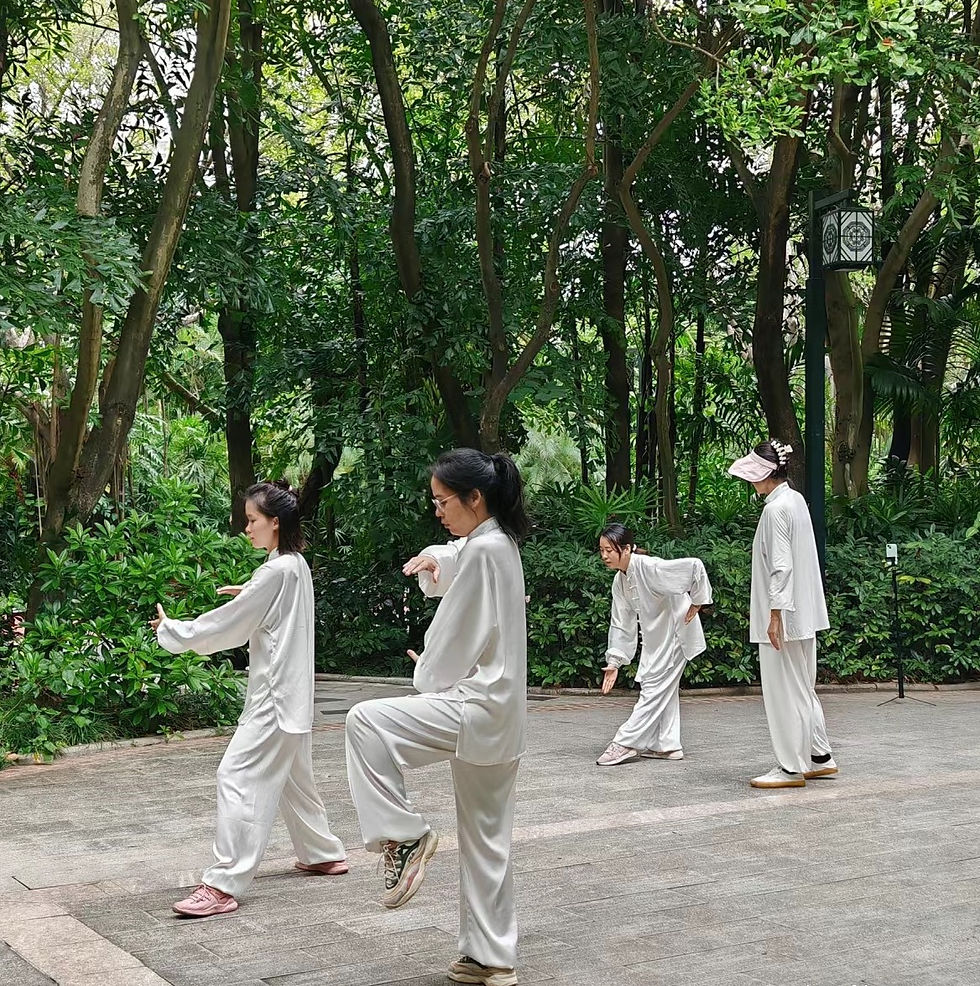Myth-busting Chinese Youth: How evolving health trends affect food and drink innovations?
- irisliu4
- Jan 4, 2024
- 6 min read
by Philix & Iris
4 January 2024
🌿Unlocking the Power of Chinese Wellness #health #wellbeing #trend #food #drinks
Youthful vibes, ancient wellness! 🌟 Dive into the next-gen health wave with insights for brands: 🚀 Swift Solutions: Fast-paced world? Grab the attention of the on-the-go youth with health products that are quick and convenient!
💆♀️ Mindful Healing: Say goodbye to the ordinary! Young minds seek psychological healing through innovative, "electronic" remedies. It's not just health; it's an experience!
🤝 Close Connections: Bridging the gap effortlessly. Successful brands resonate with the youth through seamless product design, aesthetics, and usability.
🔍 Simplicity Speaks Louder: Clear is cool. Wellness concepts presented with simplicity win hearts. No jargon, just straightforward vibes!
🔄 Share the Joy: Novelty is magnetic! Brands exploring fun and intriguing health practices are tapping into the youth's desire to share experiences. Let's make wellness viral!
🎉 In a world of info overload, youth choices aren't random. They're evolving, embracing Chinese wellness. Brands, ride the wave and stay connected!
Follow us at Cube House Works for weekly updates on Chinese market and trends. All original articles and original insights!

From indulging freely in eating, drinking, and entertainment to paying attention to the nutritional content and calories of food, the health consciousness among young people remains higher than ever. What is driving young people to start caring about their health?
Impact of the COVID-19: The powerful impact of the COVID-19 virus has left young people feel more vulnerable than before. Even after the symptoms disappear, there is a prolonged period of physical weakness, providing a direct experience of the value of health.
Concerns Arising from Sudden Illness News: Reports of young people suddenly suffering from severe illnesses or even sudden deaths have created empathy among people of the same age group and raised concerns.
Unhealthy Eating and Sleeping Habits Due to Fast-Paced Lives: The fast-paced lifestyle and work pressures can lead to compromised exercise and dietary habits, resulting in long-term lack of exercise or nutritional imbalances that burden health.
Economic Burdens Urging Young People to Stay Healthy: Treating illnesses comes with economic and time costs. For the average young working professional, falling ill is a troubling issue, making maintaining good health particularly important.
Embrace of Fitness Trends: The fitness trend gained serious momentum since the 2008 Beijing Olympics. During and after COVID, activities like frisbee, skiing, and many outdoor sports became popular among young people, turning exercise into a fashionable and social activity.
Increasing Popularity of Physical Education in Chinese Education: The country's growing emphasis on balanced education has resulted in numerous policies supporting physical health education in schools at all levels.

In 2023, a single hospital's emergency department in Zhengzhou received over 1,700 young people aged 18-25, sparking discussions on Weibo. The physical condition of young people became a focal point of discussion. This incident made some young people aware of the decline in their physical fitness, such as weakened immunity and susceptibility to common illnesses, and inadequate psychological resilience. Terms like "fragile" university students and "fragile" workers gained popularity on social media, becoming subcultures among young people (Do you know what "crispy shark" or "crispy duck" means? These are foods with a crispy outer layer that breaks easily, hence "fragile" can be understood as being vulnerable, easily injured, or falling ill).

Most young people realize the importance of health and use "fragile" as a self-deprecating term. They start discussing and seeking ways to address this unhealthy state on social media. Traditional Chinese health practices, such as Tai Chi, are being reconsidered by young people as they appear more suitable for those who may feel exhausted or prone to injury with intense exercises like running or jumping rope.
Before this shift, actions related to traditional Chinese health practices were typically associated with the middle-aged or elderly. However, the generational gap is diminishing as young people increasingly understand and accept traditional Chinese health practices. The reasons behind the rising interest of young people in traditional Chinese health practices include:
Refreshed Recognition of Traditional Chinese Medicine (TCM): Due to policy support and extensive promotion, young people have gained new insights into the culture of traditional Chinese medicine. Beyond bitter herbal medicine, practices such as acupuncture, cupping, massage, diet therapy, and music therapy are gaining attention.
Increasing Focus on Mental Health: Among Chinese youth, the shift from casual greetings like "Have you eaten?" to inquiries like "Are you an i-person or an e-person" (referring to a dimension of the MBTI personality test) indicates a growing focus on mental health. Topics related to mental health are prevalent in various contexts, with new terms circulating online, such as the colloquial query "Have you 'yu yu' today?" meaning "Are you depressed today?" Mental health has shed the stigma and is actively discussed in popular science articles and social conversations, attracting young people to the philosophical aspects of traditional health practices.
Deepening Concept of Disease Prevention: Before the pandemic, the retail sales of vitamins and dietary supplements increased by 19.8%. After experiencing the COVID-19 virus, preventing diseases became a top priority for health and wellness. The concept of disease prevention is embedded in traditional health practices, aligning with the needs of young people.
However, young people's approach to health differs significantly from that of their elders. Whether driven by the pursuit of instant dopamine or due to societal pressures, they find it challenging to break free from unhealthy habits. Their approach to wellness is characterized by simultaneous indulgence and self-preservation, termed "punk wellness." This includes wearing warm pants while drinking cold cola, using face masks during late-night sessions, and other practices.
Young people's wellness efforts fall into several categories:
Knowledge is Power: Actively consuming various health-related content online but refraining from practical implementation.
Self-rescue Amid Risky Behavior: Practicing intermittent self-discipline by engaging in compensatory wellness activities after unrestrained indulgence, only to resume unhealthy habits next time.
Replicating Elders' Lifestyle: Incorporating wellness into life with a more disciplined routine.
Chinese traditional health practices are forming a trend among young people, driven both by spontaneous adoption and active brand efforts. Some observed phenomena and cases include:

Exercise: Young people practicing Tai Chi in parks.

Wearing knee pads is the new fashion

Coke x TCM in to popular beverages with health benefits

TCM elements are blended into the formula of milk tea, welcomed by Chinese youth

Yuanqi Senlin's latest innovations using TCM elements

Chinese traditional massage parlor transformed to appeal to youth with new design and marketing

Home acupuncture kit targeting at young people

In addition to physical wellness, young people are also actively exploring mental wellness. Recently, the trend of "electronic Chinese medicine" has gained popularity on social media platforms. This refers to music derived from the traditional Chinese medicine five-tone therapy (Gong, Shang, Jiao, Zhi, Yu), with each tone corresponding to different organs. Listening to music in the appropriate tone at specific times is believed to have therapeutic effects. Similar philosophies are observed in activities like singing bowl sessions, attracting a young audience. These spontaneously emerging wellness trends serve to address the anxiety surrounding physical and mental health among young people, providing a therapeutic aspect to the wellness process.
Our Exploration and Reflection:
The focal point of the younger generation's health consciousness is multifaceted, surpassing conventional practices and embracing innovation within the realm of "Chinese wellness." Consequently, brands should strategically address various aspects:
Emphasis on Expediency: In an era marked by information saturation and rapid lifestyles, products offering prompt and convenient solutions hold heightened appeal for the younger demographic.
Psychological Restoration: Unlike the tangible and chemical interventions required for nutrition or treatment, psychological healing can be achieved through intangible means such as textual or audio-visual content. In the prevailing electronic culture, cost-effective or cost-neutral "electronic" remedies entice young individuals to act or make purchases. Brands, in their product design or marketing, should explore leveraging current psychological trends.
Establishing Proximity: Early traditional health practices suffered from a lack of resonance with the younger population, failing to capture their attention. Brands aspiring to incorporate traditional health practices to attract a youthful audience must actively discern and fortify the connection between the two, encompassing product content, aesthetics, and usability.
Strive for Simplicity: In the realm of scientific health discourse, the consumer decisions of some young individuals are influenced by professionalism. Whether rooted in scientific research or traditional texts, a rational foundation is often perceived as indicative of professionalism. Brands can effectively present wellness concepts or knowledge in a clear and conspicuous manner to their audience.
Facilitate Social Sharing: Novelty acts as a magnet, drawing a considerable number of young individuals. In health-related discussions, unique aspects are not confined to the intersection of traditional wellness culture with the younger generation. Brands can delve into intriguing applications or practices, harnessing the desire of young people to share experiences to amplify promotional impact.
In this epoch of readily accessible information, young individuals are exposed to a myriad of data through diverse channels, shaping their perceptions. The health-related choices made by this demographic are not arbitrary; the growing comprehension and acceptance of traditional Chinese wellness culture among young people signify that their preferences will adapt and transform with shifts in awareness, particularly the embrace of traditional wellness culture. Brands must be attuned to the cultural and societal contexts within which young individuals navigate as they explore emerging trends.


Comments